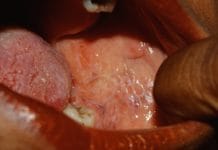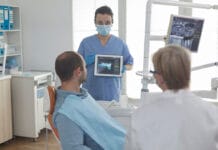Working as a clinical dental hygienist can lead to aches, stress, and occasional pain. It’s fairly common that a dental hygienist may encounter these discomforts throughout his or her career. Dental professionals are more susceptible to musculoskeletal disorders and often cope with these occupational hazards.
Fortunately, there are many ways to relieve and prevent the aches and pains associated with the profession. Physical activity is among the ways in which a dental hygienist can relieve work-related discomfort. There are many styles of fitness that a dental hygienist can do to stay proactive against work-related pain. The following are my top three exercises for the dental hygienist.
Spin
A spin class is a high-intensity indoor cycling workout on a stationary bike with varying resistance, body positioning, and speed. Indoor cycling will increase muscle definition in your legs, back, and core. Exercises that allow for the strengthening of your core is essential and improves your ability to hold your body upright. Improving and strengthening your core automatically improves your posture.
The varying positions involved in a spin class will support your back, and the pitched-forward position provides toning and strengthening to muscles along your spine. Indoor cycling is considered low impact, which suggests a low risk of injury. The bike is stationary, so the exercise won’t cause tension on the hip or put excessive pressure on knee or ankle joints.
Most often, spin is served in a class format. New at-home equipment such as the Peloton allows this type of fitness to be accomplished conveniently in your own home. However, I recommend considering the group class in that it is exhilarating and motivational. It can serve as “me time,” which transcends habits that relieve work-related stress and pain. The class environment allows individuals to push themselves and strive for fitness goals every single class.
Indoor cycling benefits your overall health, including but not limited to cardiac health. As health-care providers, it’s important to practice what we preach.
Barre
Second, give a barre class a try! Barre classes are ballet-inspired fitness workouts. This style of fitness is also considered low-impact and emphasizes the overall conditioning of your body. Barre class will target strengthening your core, arms, glutes, back, and legs through high repetition of small range movements of your body. This focuses on core muscles that are important to the dental hygienist.
Barre is highly recommended since you have the ability to build strength, enhance posture, and improve balance. Each of these benefits will reinforce your posture and continually strengthen your core, therefore improving your ergonomics at work.
“The emphasis on proper alignment, balance, and core engagement means the classes move at a slower pace. You might not leave a ballet-inspired class drenched in sweat, but you’ll feel the burn after a class thanks to moves that target specific muscle groups.”1
Barre classes are popular and offer levels from beginner to expert, depending on your comfort level. The class offers several modifications for each exercise throughout the class, making it a great option for beginners. It’s evident that barre class improves physical strength, which can promote a healthier and happier way of life.
Yoga
Finally, let’s discuss yoga! The profession of dental hygiene demands physical and mental energy. Yoga can provide countless physical health benefits through relaxation techniques. Yoga is beneficial for the dental hygienist because it has the power to promote relaxation for both the mind and body.
“The benefits of yoga can notably reduce chronic pain, such as lower back pain, arthritis, headaches, and carpal tunnel syndrome.”2
Yoga has been proven to improve balance, release tension in your limbs, and increase immune functionality. Yet again, the physical benefits for the dental hygienist are to ultimately decrease physical discomforts.
Many types of yoga classes are available for beginners up to intermediate levels. With so many options available, it means anyone can participate and benefit from the healing practices of yoga. It can be done in your home or a class setting.
There is also the option of using yoga apps to guide you through your practice. Download an app such as Pocket Yoga, and that enables you to practice at home, during lunch, or in between patients. Incorporating a physical activity such as yoga will aid in decreasing the occupational risks of bodily aches, pains, or musculoskeletal disorders.
These are just a few examples of physical activities that can benefit the dental hygienist. It is crucial that dental professionals consider the longevity of their careers. I highly recommend creating habits that are proactive to ensure appropriate self-care, which ultimately decreases day-to-day discomforts that come along with practicing as a dental hygienist.
Before you leave, check out the Today’s RDH self-study CE courses. All courses are peer-reviewed and non-sponsored to focus solely on high-quality education. Click here now.
Listen to the Today’s RDH Dental Hygiene Podcast Below:
References
- Helmer, J. (2018, November 23). Barre Classes: Benefits, Exercises, and What to Expect. Retrieved from https://www.webmd.com/fitness-exercise/a-z/barre-workouts
- Benefits of Yoga. (n.d.). Retrieved from https://osteopathic.org/what-is-osteopathic-medicine/benefits-of-yoga/











